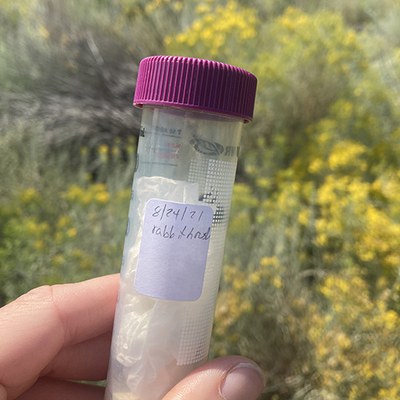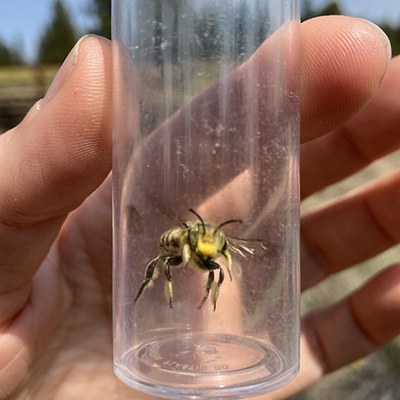On a sunny, smoke-free August day, I headed out to the Land Trust’s Camp Polk Meadow Preserve. My goal for the day: to learn more about bee surveys happening at our Preserves and across Oregon through the Oregon Bee Atlas.
Now perhaps you are having the same reaction that my husband had when I told him I’d be headed out for bee surveying—“What are bee surveys??” And it’s a great question! Let’s start at the beginning. In Oregon, there has never been a formal survey of our native bees. This makes things difficult for scientists: they can’t really say whether our bee populations are increasing or decreasing, understand the effects of wildfire and climate change on bee species, or have any type of baseline about bees. Through a partnership of the Oregon State University Extension Service, the Oregon Department of Forestry, and the Oregon Department of Agriculture, the Oregon Bee Project was born, and one of their tasks is the Oregon Bee Atlas.
For the past five years, volunteers and partners have been working on documenting Oregon’s native bee populations through the Oregon Bee Atlas. Last year, the Land Trust installed bee boxes at six of our Preserves for this project. Now, volunteers with the Oregon Bee Atlas are collecting bee species at places like Camp Polk Meadow Preserve and Whychus Canyon Preserve for additional surveying.
When I arrived at Camp Polk Meadow Preserve, I met Oregon Bee Atlas volunteer Michele Sims. Clad in bee-inspired clothing, Michele not only has an interest and passion for bees, but wildflowers, trees, and many other nature-related things. She was happy to take this bee newbie under her wing (pun intended!) and teach me some of the basics about what she was doing.
Michele impressed me with her swooping netting skills, giving her a chance to look at the bee more closely and ensure it was a bee that needed to be surveyed for this scientific endeavor. After being collected and labeled by what flower the bee was on, we moved slowly along the trail, eyes trained on anything small and with wings. Michele showed me a bee with pollen stored on its abdomen and a male bee with pollen on its nose. She also gave me all sorts of tips for identifying flies, wasps, and bees that imitate other insects, with the caveat that it’s really hard to identify bees! This is why Michele will send in her bees to Oregon State University. There, they will actually DNA sequence the bees to identify the species.
As Michele and I completed the loop trail, it was difficult to stop staring at the rabbitbrush and the buzzing bees, even after two hours. I was doing one of my favorite things—nerding out on the science of the natural world. And even though my time as a pseudo bee surveyor had to come to an end, I look forward to learning and hearing more about our native bees and being fascinated by what they do.
Learn more:


